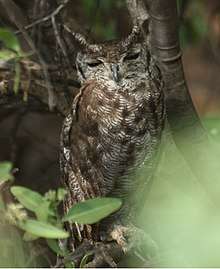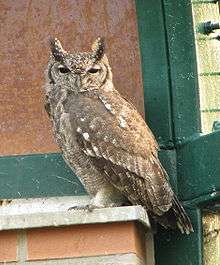Greyish eagle-owl
The greyish eagle-owl or vermiculated eagle-owl (Bubo cinerascens) is a rather large owl of the northern part of Sub-Saharan Africa. It was previously regarded as the northern subspecies of the spotted eagle-owl (Bubo aficanus).

| Greyish eagle-owl | |
|---|---|
 | |
| Scientific classification | |
| Kingdom: | Animalia |
| Phylum: | Chordata |
| Class: | Aves |
| Order: | Strigiformes |
| Family: | Strigidae |
| Genus: | Bubo |
| Species: | B. cinerascens |
| Binomial name | |
| Bubo cinerascens Guérin-Méneville, 1843 | |
Description
This species is about 43 centimetres (17 in) long and weighs about 500 grams (1.1 lb).[2] Like the spotted eagle-owl, the greyish eagle-owl has mottled dark brown, buff, and white upperparts and finely barred (vermiculated) underparts giving a greyish-brown appearance. It differs from the spotted eagle-owl in having dark brown (not yellow) eyes and a brownish facial disk marked with a heavy brown circle around each eye.[3] It also has morphological differences, such as being lighter though about the same length and having shorter tarsi.
Voice
As the greyish eagle-owl was considered the northern form of the spotted eagle-owl until recently their vocalisations have not been well studied. The call of the male recorded in West Africa consisted of two clear syllables and has been rendered as "koo-whoo" where the "koo" part is rather explosive and the "whoo" is somewhat downward inflected, lower pitched and extended.This call is made every few seconds and is thus not similar to that of the spotted eagle-owl.[4]
Distribution and habitat
It is found in the northern part of Sub-Saharan Africa from Mauritania and Liberia east to Sudan and Somalia.[5] Its habitats include dry rocky deserts and open savannah, as well as lowland forests in Somalia.[2]
Biology
Roosts during the day hidden and sites used vary from rocky natural sites such as cliff crevices and boulders to bushes and trees to man-made sites. It feeds on larger insects and other large arthropods as well as vertebrates. It usually hunts from a perch, using a sit and wait technique, but may also hawk insects and sometimes bats in flight. The breeding biology is probably similar to the spotted eagle-owl. It lays 2-3 eggs in a scrape on the ground or among rocks or in a sheltered cliff site, although it will sometimes reuse the old platform-like nests of larger birds in trees.[4]
Taxonomic note
It is closely related to the spotted eagle-owl, of which is it sometimes considered the northern subspecies, Bubo africanus cinerascens.[3][5] In the area of overlap with the spotted eagle-owl in Kenya and the Horn of Africa, the two species are not known to interbreed.[2][4]
References
- "Bubo cinerascens (Greyish Eagle-owl)". IUCN Red List of Threatened Species. Retrieved 24 October 2016.
- Weick, Friedhelm (2006), Owls (Strigiformes): Annotated and Illustrated Checklist, Springer, pp. 111–113, ISBN 978-3-540-35234-1
- Zimmerman, Dale A.; Turner, Donald A.; Pearson, David J. (1999), Birds of Kenya and Northern Tanzania, Princeton University Press, pp. 128–9, 374, ISBN 978-0-691-01022-9
- König, Claus; Weick, Friedhelm; Becking, Jan-Hendrick (1999). Owls A Guide to the Owls of the World. Pica Press. pp. 301–302. ISBN 1-873403-74-7.
- Lepage, Denis (2003–2007), Avibase - the world bird database, retrieved Sep 22, 2007
External links
- Videos of the Greyish Eagle-Owl from the Internet Bird Collection
